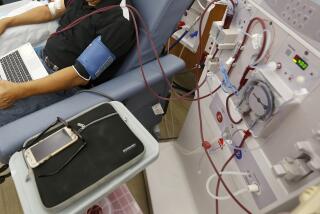Holan Begins Road to Recovery
- Share via
The most extraordinary thing about Milos Holan’s moment of high drama Wednesday morning was how ordinary it seemed when it arrived.
At about 4 a.m., in a quiet hospital room at the City of Hope National Medical Center in Duarte, a nurse started the transfusion of about a liter of bone marrow--the gift of an anonymous donor--into a catheter implanted in Holan’s chest.
The procedure looks almost like an ordinary blood transfusion, but Holan, with his pregnant wife, Irena, at his bedside, was receiving the life’s blood that can cure his leukemia.
“It has such emotional significance, even though it does not look very dramatic,” said Dr. Stephen Forman, the director of hematology and bone marrow transplantation at the City of Hope who is treating the Mighty Ducks’ defenseman.
“I learned from patients many years ago that they separate their life into two lives: Life with cancer before the transplant, and life without cancer from the date of their infusion on. After the infusion, they are leaving cancer behind.”
Holan, 24, was listed in stable condition after the three-to-four-hour procedure, but his battle is far from over. The next 3 1/2 weeks will be critical to his recovery.
His immune system was destroyed by a weeklong regimen of radiation and chemotherapy. Until the donor’s healthy marrow takes hold and begins to build a new immune system, Holan is susceptible to infections and other life-threatening complications. He must remain in isolation in a room with a special air-filtering system.
Patients typically remain hospitalized about six weeks, though it can be much longer if there are complications, and they remain under a close watch for the first few months at home. Many patients begin to feel better after about six months, but full recovery is considered to take about a year.
The sports world has seen dramatic cancer recoveries in recent years. The Pittsburgh Penguins’ Mario Lemieux, who was treated for Hodgkin’s disease, has returned to dominate the NHL, and PGA Tour player Paul Azinger has returned to competition after being treated for lymphoma.
Holan has understood from the beginning that his case is more serious, and when people in hockey circles mention Lemieux, he has politely and quietly told them, “This is different.”
“This is much more difficult and much more risky,” Forman said. “The question in this case is survival.”
A patient such as Holan, who was found to have a slow-progressing form of leukemia after a routine blood test during a training camp physical in September, has about a 60% chance of a cure with a transplant from an unrelated donor.
Without a transplant, doctors told Holan, his condition would almost certainly be fatal.
Holan’s only sister, Radka, was not a match, and doctors began searching the National Marrow Donor Registry for a compatible donor. Publicity surrounding the illnesses of Holan and Rod Carew’s daughter, Michelle, who also has leukemia, have helped push the list of registered donors past 2 million. In January, four months after his disease was discovered, Holan learned that a donor had been found.
“Some people wait their whole life for a donor, and some people die,” Holan said at the time. “I’m the lucky one.”
Duck defenseman Randy Ladouceur, Holan’s roommate on the road when Holan played 16 games this season as the search for a match went on, said the players have been optimistic about Holan’s prospects.
“We were sure they’d find a match, and maybe we really don’t know how lucky he is to have found one,” Ladouceur said. “Maybe he’s luckier than we think he is. This is just another step toward his recovery.”
Holan’s teammates have been eager to offer support and visit, they understand it will be some time before he is ready.
“Irena told me he would prefer people wait a few weeks until he’s feeling better,” team physician Craig Milhouse said. “She said Milos is not in the best of moods and that’s totally normal. He feels terrible. If you were sick with the stomach flu, you wouldn’t be in a talkative mood and want to sit down and visit. This is worse than something like that, worse than most people can imagine unless they’ve been through it.”
The marrow that can give Holan a new life was extracted from the pelvis of a donor during an hourlong surgical procedure in another city, then transported to the City of Hope, where Holan was ready and waiting.
“I think most [transplant recipients] are aware the day is there, though they tend to feel fairly wiped out from the chemotherapy and radiation,” Forman said. “There are no bells and whistles, but family members recognize that what they’ve worked so hard to achieve is happening, and the person now has a real opportunity for overcoming the disease.”
Under National Marrow Donor Program guidelines, the donor remains anonymous for a year, to diminish the emotional pressure on the donor or recipient. But after a year, Holan might have the opportunity to meet the person who will have saved his life.
“With an unrelated donor, the transplant is even more dramatic because it requires coordination with another place and another person,” Forman said. “A person you don’t know acts almost out of civic responsibility, for the good of mankind, as opposed to a family member. We know that somewhere today there is a donor going home knowing that they gave a transplant to someone in Los Angeles.”
More to Read
Go beyond the scoreboard
Get the latest on L.A.'s teams in the daily Sports Report newsletter.
You may occasionally receive promotional content from the Los Angeles Times.






